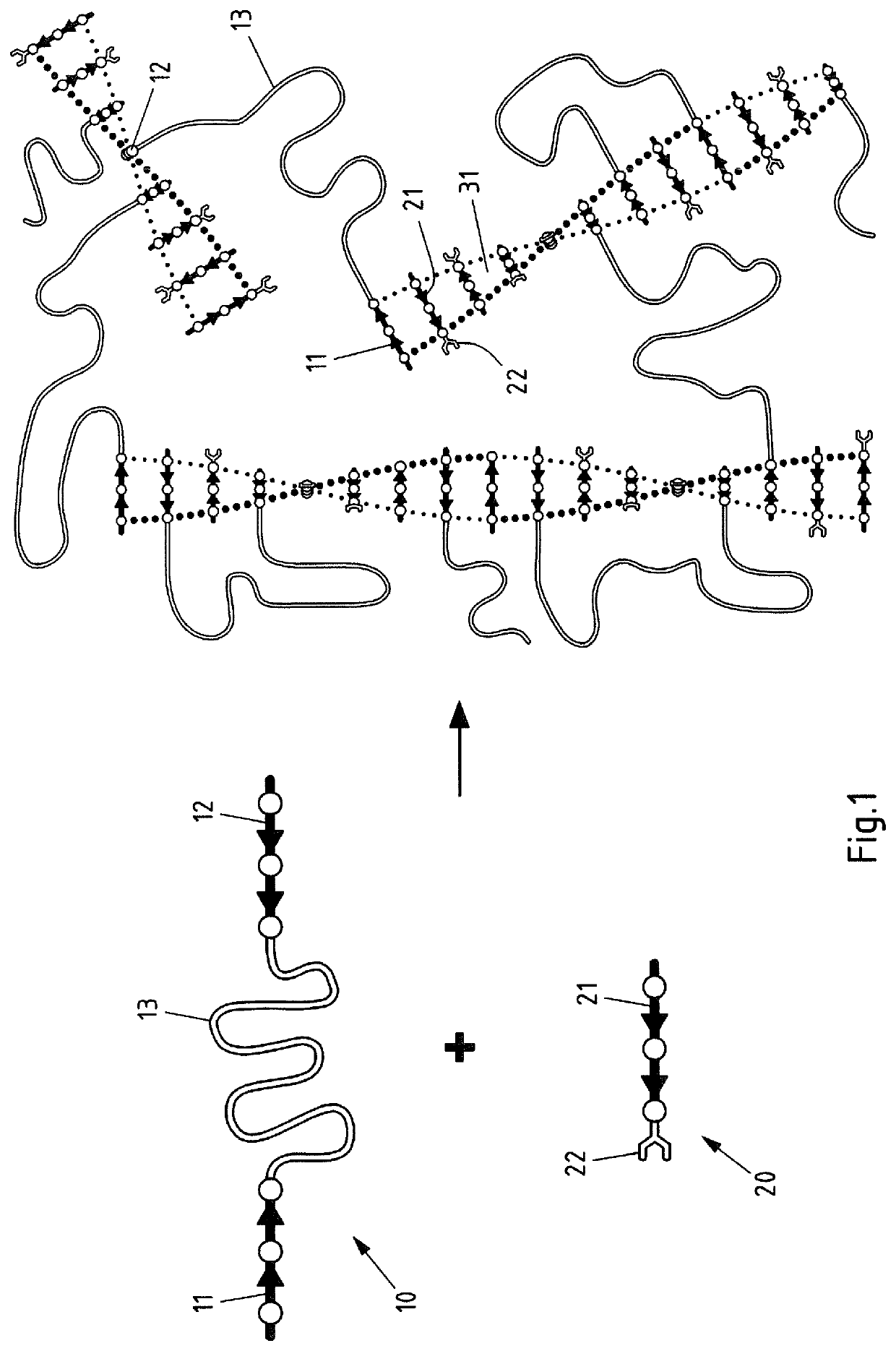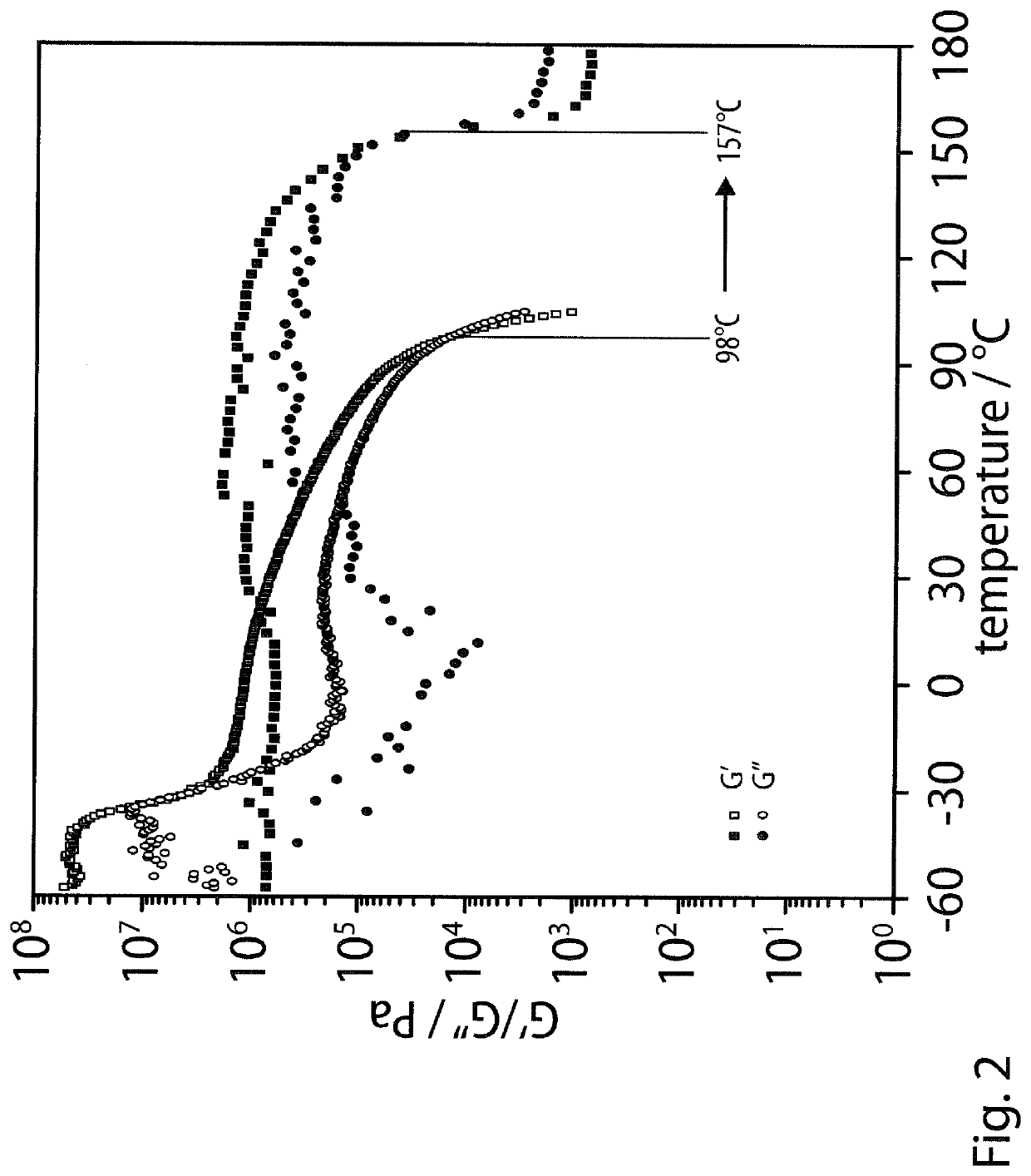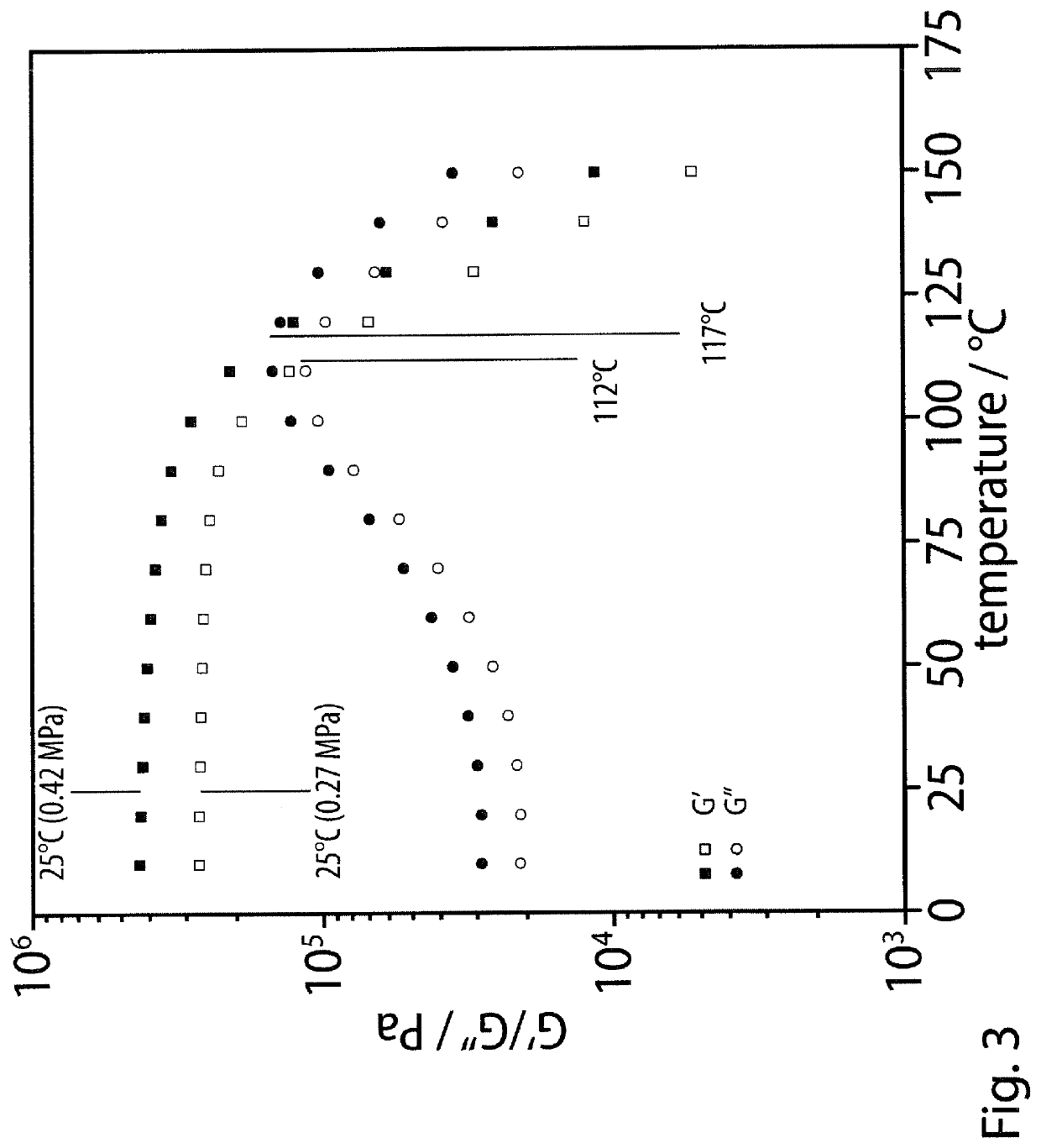However, existing TPE solutions are unable to fulfil the stringent performance requirements in many applications, particularly in the
automotive industry, owing to either their insufficient
thermal stability and
creep resistance, or their inferior elasticity and shape
recovery.
Such materials behave as elastomers in that they show quasi-instantaneous shape
recovery on loading and unloading at the
operating temperature, T. However, unlike conventional vulcanized rubber elastomers, they do not contain a continuous network of covalent crosslinks, and may therefore be melt-processed at temperatures exceeding the
glass transition temperature, Tg, or
melting temperature, Tm, of the rigid domains [J. G. Drobny, Handbook of
Thermoplastic Elastomers, 2nd edition, Elsevier 2014].
Indeed, a major challenge currently faced by the industry is the development of TPEs that combine a high
softening temperature, Ts (≥150° C.
This is driven by an increasing demand for high temperature elastomers e.g. for under-hood applications in the
automotive industry, which most commodity vulcanized rubbers fail to meet, owing to their poor high temperature stability, which is typically limited by their
chemical stability.
Of these, EPDM is most widely used in automotive applications such as
brake seals and radiator gaskets, but it performs poorly in contact with
petroleum oils, lubricants and fuel.
Conversely, acrylic rubbers show poor properties in contact with
moisture, acids and bases.
The main
disadvantage of
silicone-based HTVs is their high price, typically 7 to 10 times that of commodity vulcanizates.
They also show limited resistance to
strong acids & bases, alcohols and fuel, and have modest mechanical properties, in particular, low tensile strength compared with commodity vulcanizates.
High temperature
fluorocarbon, fluorosilicone and perfluorocarbon rubbers also suffer from moderate mechanical properties, and they are between 30 and 1000 times more expensive than commodity vulcanizates.
At present, the low Tg or Tm of the rigid domains in the commonly employed SBCs, TPOs, and TPVs renders them unsuitable for use at temperatures above 90-100° C.
By contrast, the
softening temperatures, Tg, of
heat resistant TPVs, COPEs and PAEs may exceed 200° C. However, such materials typically show a far more
restricted range of softness /
hardness than vulcanizates, and, in the case of COPEs, a very low elastic limit of around 10-15% [A. K. Bhowmick, H. L. Stephens, Handbook of Elastomers, Marcel Dekker 2001].
Nevertheless, although the applications of TPUs now range from heavy-duty transmission belts to prosthetic fingers, their use in tires has remained limited to slow-moving vehicles in controlled environments, such as electric indoor forklift trucks, and temporary components, such as run-flat inserts.
Moreover, TPUs tend to perform poorly at high speeds owing to
heat generation and consequent instabilities, such as meltdown under braking [A. K. Bhowmick, H. L. Stephens, Handbook of Elastomers, Marcel Dekker 2001; C. Prisacariu,
Polyurethane Elastomers: From Morphology to Mechanical Aspects, Springer 2011; Weblinks: http: / / www.thombert.com / website / white papers / PolyurethaneRubberTires.pdf, http: / / tomdwyercom / 2011 / uncategorized / will-
polyurethane-replace-rubber-for-tires].
However, their range of
hardness / softness is far smaller than that of the HTVs and indeed it is debatable whether many PAEs can be considered to be true elastomers based on their mechanical behavior.
Moreover, the mechanical properties of PAEs cannot be tailored to specific purposes, in particular, it is not possible to achieve good elastomeric properties and high melting points simultaneously.
Silicone-based HTVs on the other hand suffer from the fact that they are difficult and, therefore, expensive to process.
Moreover,
silicone-based HTVs can only be used in a limited number of environments.
Finally, the mechanical properties of
silicone-based HTVs are only modest.
This is because the high degrees of
crystallinity necessary to ensure resistance to high temperatures in these materials are incompatible with desirable properties in elastomers, such as resilience, low tensile moduli, and low
hysteresis.
While typical TPEs based on COPEs, TPUs, or PAEs show high stability and
creep resistance, but suffer from inferior elasticity and
hysteresis-free shape
recovery, materials based on polymers with distinct
hydrogen-bonded self-assembling end groups, such as oligopeptides, oligoamides, oligourethanes, or oligoureas have so far received very little attention in the related scientific and
patent literature.
In all of these cases, however, the
hydrogen-bonding interactions between the oligoamide or
oligopeptide segments merely supplement a covalent network obtained by
vulcanization, supposedly because purely supramolecular elastomers have shown insufficient
mechanical strength at large strains.
High temperature stability is also an important issue for many amorphous or semicrystalline commodity thermoplastics, which are unable to compete with more expensive
engineering polymers in applications such as under-bonnet automotive parts that are subject to sustained and / or transient
exposure to elevated temperatures.
3601]. However, as with
thermoplastic elastomers, significant improvements in performance are often achieved at the expense of processability and recyclability owing to the concomitant increases in
melt viscosity [T. C. B. McLeish, Curr. Opinion.
Solid State Mater. Sci. 1997, 2, 678-682], and in the case of semicrystalline polymers, too high a
molar mass may lead to reduced
crystallinity with adverse consequences for strength and stiffness [M. G. Andersson, J. Hynynen, M. R. Andersson
46-156]. An extreme example is provided by ultra-high molecular weight poly(
ethylene), which has outstanding abrasion resistance, but cannot be processed using conventional techniques such as
extrusion of thermo
However, although crystallizable isotactic and syndiotactic grades of poly(
styrene) are available, they are more expensive, and difficult to process owing to their high melting temperatures.
Another major problem with commercial general-purpose poly(
styrene) is that it shows very limited elasticity above Tg owing to their low entanglement densities.
This severely limits not only their dimensional stability when they are subjected to transient
exposure to temperatures above Tg, but also their processability, leading to poor results in film blowing, for example, and problems with non-uniform
cell morphologies and excessive open pore content during foaming.
Poor melt strength is a recurrent problem not only with widely used amorphous polymers such as poly(
styrene) and poly(
methyl methacrylate), but also many semicrystalline polymers, including polyolefins such as poly(
ethylene) and poly(propylene), and polyesters, for example, whose
processing temperatures are generally well above Tg, i.e., well above the temperature range corresponding to the rubbery
plateau.
Poor melt strength may
impact not only film blowing and foaming, but also a wide variety of other processes involving
extrusion or
thermoforming.
However, the use of BTA as low-molecular-weight additives with specific interactions with polymer end and side groups has never been reported.
In all of these cases, it is worth noting that the use of additives that are based on the same complementary supramolecular motifs inevitably results in competitive interactions that lead to a breakage of network points in supramolecular polymer networks and hence a weakening of the resulting elastomers [X. J. Loh, J. del Barrio, P. P. C. Toh, T.-C.
However, their shear moduli G′ typically do not exceed 1 MPa and, most importantly,
softening temperatures, Ts, which are dependent on the melting or disaggregation temperatures of the
hydrogen-bonded ligands, are typically below 100° C., so that their maximum operating temperatures are insufficient for many technological applications.
The materials described above do not even allow for modifications of their thermomechanical properties by use of additives based on complementary supramolecular interactions, as these would result in a breakage of the network points due to competitive intermolecular interactions.
The development of novel TPEs that combine high moduli, high operating temperatures, excellent elasticity, low
hysteresis, and shape recovery at large strains remains an outstanding challenge.
Since all of these previous examples have in fact focused on monofunctional polymers (with only one
oligopeptide end group) limited to
network formation by entanglement of the nanostructures, the resulting mechanical properties have hence remained inferior to those of simple hydrogen-bonded supramolecular elastomers (see above) and even standard TPE, in
spite of the claimed formation of nanofibrillar aggregates.
Self-
assembly may also be increasingly kinetically hindered for increasing
molar masses of the polymers tethered to the oligopeptides as the
viscosity of the polymer matrix increases.
 Login to View More
Login to View More 


